Saturday, January 15: Winter in Hanoi is not winter in Korea, or even in Washington for that matter, but it’s cold enough. Especially since I’ve brought only lightweight clothing. Layers and layers, but cotton and knits, not wools and down.

some fellow junks on halong bay
Maybe because of this chilly and overcast weather, we are just three in the van cruising from Hanoi to Halong Bay . Each on our own bench seat, we can stretch out like lazy cats and enjoy the ride. Enjoy? Wait. We are driving slowly, as everyone seems to do in Hanoi, but the driver rolls across the center line and then lackadaisically meanders head-on toward the oncoming traffic. At the last minute, he cuts smoothly in front of the truck in the right lane, and continues on until the next time he repeats the same. On this 4-hour drive, he plays chicken too many times to count. There seems to be some logical order to this kind of driving in Hanoi, but frankly, it doesn’t make for a very relaxing drive.

indochina junk
The road is chock-full of bicycles and motorbikes and slow-moving trucks piled high with all manner of tropical fruits, sugar cane, green leafy vegetables. One couple whizzes by; the driver has a huge sack of rice between his legs. Debris dots the roads, the businesses, the yards. Another motorbike scoots past with dead unplucked roosters piled high behind the driver. Weathered shacks and paint-chipped houses fly by. At temples along the roadside, incense smoke spirals upward, prayers to the Buddha. The yellow haze of Hanoi follows and envelops us like an old ratty blanket, too threadbare to cushion any head-on collision. Ruth comments on the ever-present haze: “At least it’s atmospheric!”
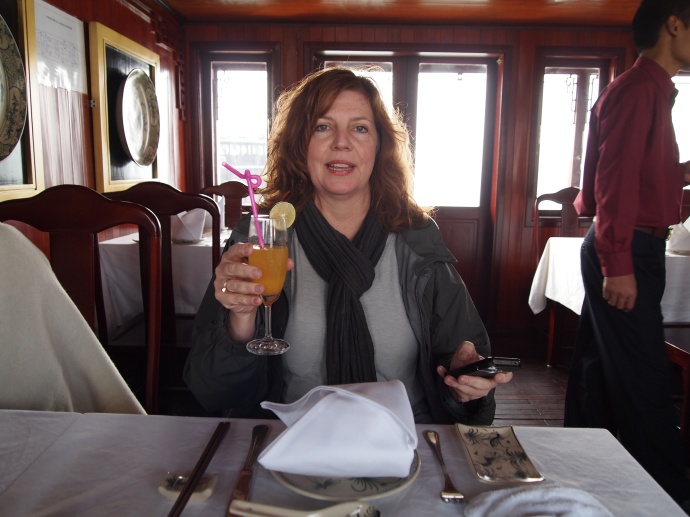
Ruth
Ruth, a redhead who lives in Toronto but was raised in Australia, is in the seat directly behind the driver. She’s working in Hanoi for 3 weeks helping Vietnamese community colleges with strategic planning through a contract with the Canadian equivalent of USAID. She’s close to my age and we immediately strike up a conversation, finding we have a lot in common. She has teenage children in college, she’s been married and divorced twice, and she loves to travel.
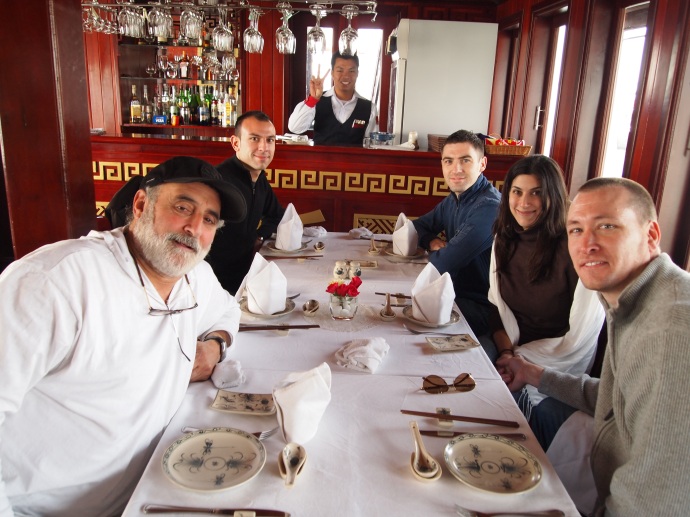
Ken, the two French boys, Thea & Ryan
Behind me, in the third seat, is Ken, a bearded New Yorker with a hearing aid who’s retired but traveling around the world, volunteering as he goes along. Mostly teaching English, apparently. He tells us that he was practically deaf for 5 years but had a cochlear implant. Now he’s just “hard of hearing.”
We make a stop at a “happy room,” which is basically a shop for tourists that has a bathroom. I buy a bunch of Vietnamese souvenirs, sucker that I am: a buffalo tusk bracelet, an alabaster box with a carved vine of pretty flowers, a leaf box, placemats, and a lacquer picture that looks like an impersonation of Gauguin. Ruth buys some scarves. We use the “happy room” and head on our way.
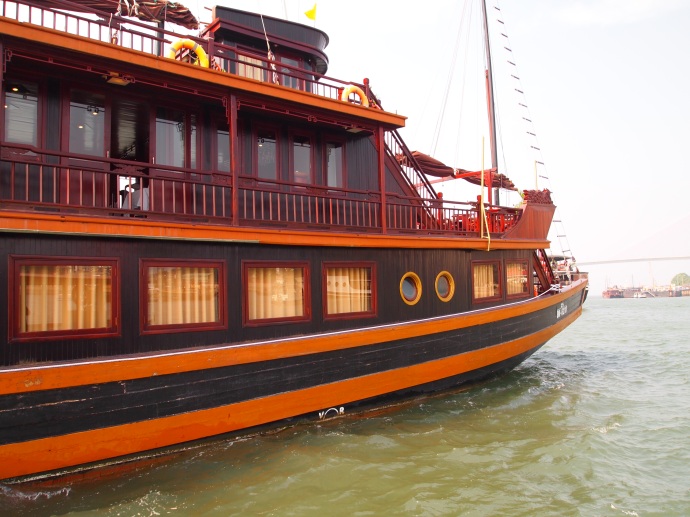
the dragon pearl III
We arrive at Halong Bay and board a little motorboat that takes us out to the Dragon Pearl III, our own personal junk moored in the bay. We luck out in that there are just 9 of us on a junk that holds 22. We meet our fellow passengers, Julia and Christo from France, Pasqual and his friend (name forgotten), also French. Thea and Ryan hail from Brooklyn; they’re a couple in their 30s who take one big trip every year. Thea has her own public relations firm and Ryan works for a software company that enables online banking. Ken, Ruth and I make nine.
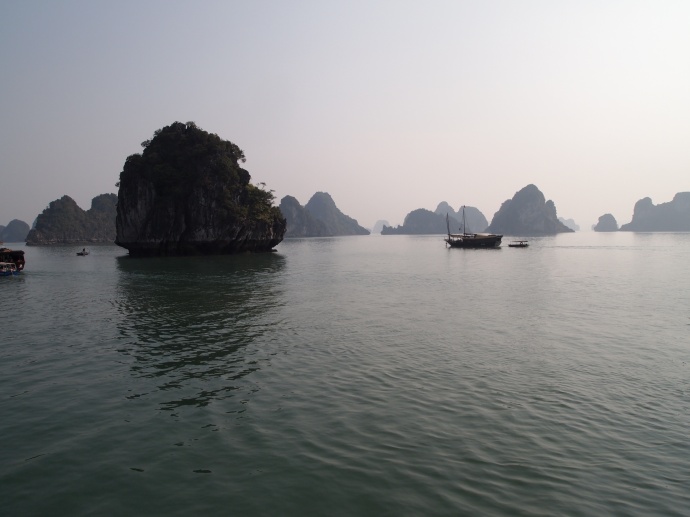
halong bay ~ descending dragon

cruising into Halong Bay on our junk
When I first meet Ryan and Thea, they ask if I have kids and I say yes. But I’m not the kind of mother whose life revolves around her kids. Sometimes, I say, raising kids can be pure drudgery. I think Ryan is taken aback by that and during the rest of the cruise, I feel he’s a little stand-offish, possibly judgmental. They are in their 30s and of course see children in their future.
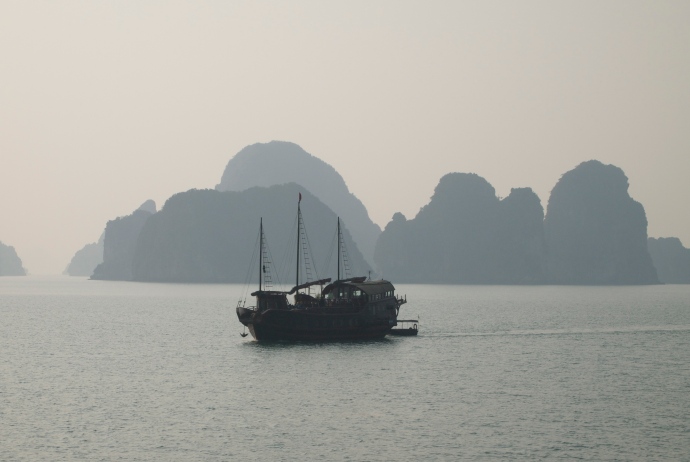
Halong Bay
Underway on the boat, all polished dark wood and gleaming brass, our guide Thanh tells us there are 1969 islands in Halong Bay. Its name means “descending dragon,” and it’s been recognized by UNESCO twice. As we cruise along, we marvel at the limestone karsts and isles that make Halong Bay famous. Legend has it that the gods sent a family of dragons to defend the land of Vietnam. The dragons spit out jade and jewels which became the chain of islands that served as a blockade against Chinese invaders. Later, the dragons settled here to live peacefully. The place where the mother dragon descended is called Halong Bay. It’s quite lovely looking out from our little junk, as we cruise along, at rock formations shaped like slit-eyed monster faces and other imaginary notorious creatures.

Thanh, our guide on the Dragon Pearl III
Our phenomenal 9-course lunch, which Thanh introduces to us by reading aloud the extensive menu, includes: soup with red beans and lotus seeds, slivered vegetable salad with carrot juice, Halong clam with fragrance smooth fruit and cilantro, oyster cakes with garlic sauce, deep-fried prawns with garlic and butter, steamed sea bass with soya sauce and vegetables, cabbage with garlic, steamed rice, and tropical fruits for dessert: passion fruit, watermelon and oranges. I add a beer and a glass of red wine for good measure.

steamed sea bass
At lunch, we all share our travelers’ tales. Thea and Ryan have been to South Africa; they loved Cape Town but not Johannesburg. Ken went to Zimbabwe and Tanzania and loved Peru with Machu Pichu and its huge sand dunes and rain forests. Ryan also loved Peru. Thea and Ryan spent a couple of days in Tokyo on their way to Vietnam. They have often done home exchanges and say they did one with a couple in Montreal, which they loved. Montreal is where Ruth’s kids go to college. Ruth tells about hiking the mountains in Morocco.
After lunch, we try to sit on the cushioned lounge chairs on the top deck, but it’s downright cold. I walk around on the deck, shivering and taking pictures; I come across Ryan and Thea huddled under royal blue towels on the lounge chairs.

the lounge chairs on the deck ~ too cold to lounge!
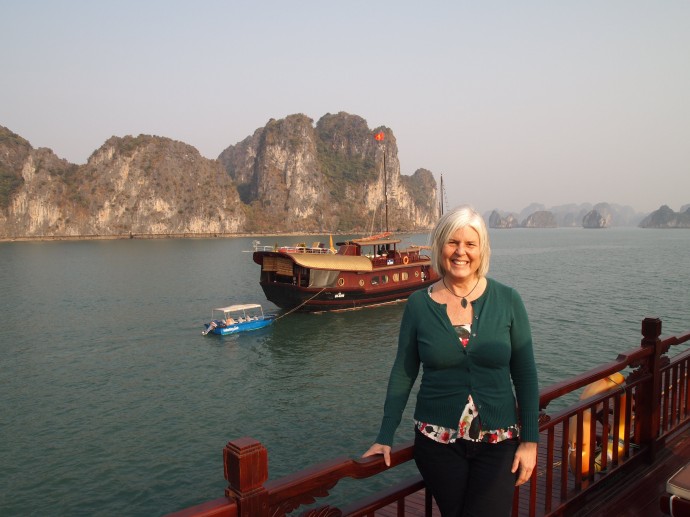
on the good ship dragon pearl
Wanting to be warm for a while, I retreat into my cozy cabin where I write a while and take a short nap.

my cabin on the dragon pearl III
After lunch, we are given the keys to our cabins and told we can settle in. A little later, the crew instructs us to put on the rubber slippers in our cabin closets because we’re going to explore caves on a little island. My slippers are about twice the length of my feet, so I feel like some kind of cartoon character harumphing about in them.
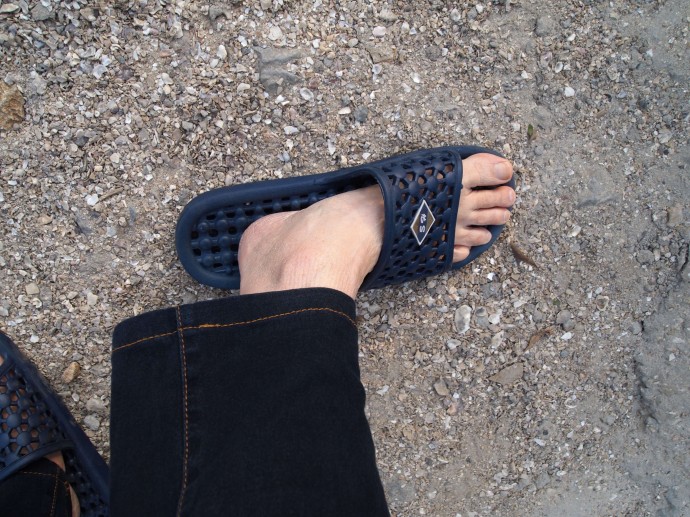
I feel like a little girl wearing my father’s shoes

the captain
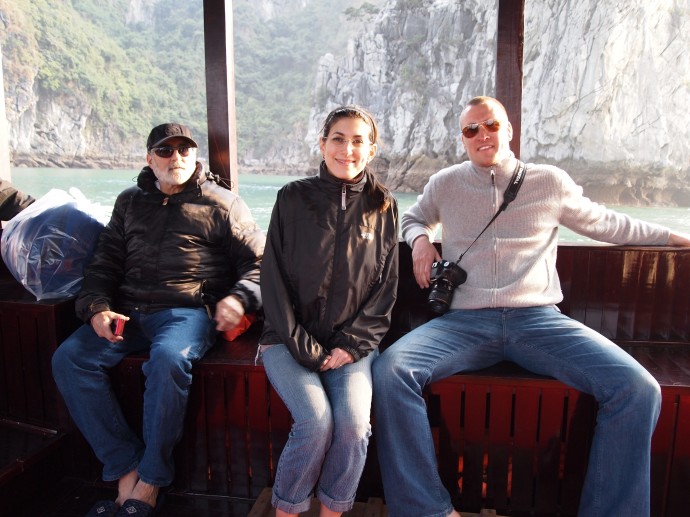
ken, thea and ryan

the little island where we lay anchor
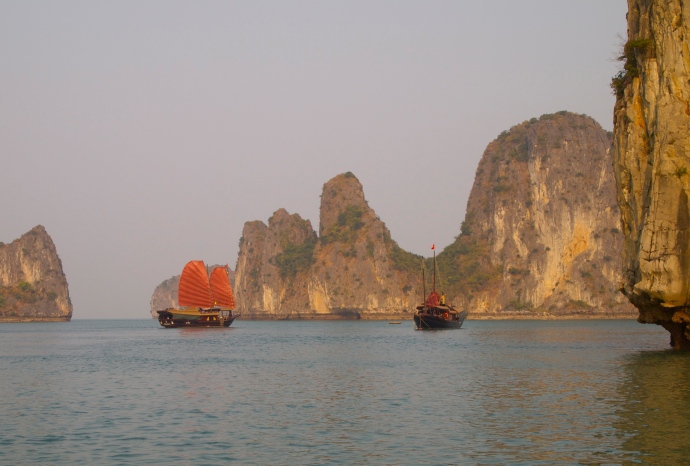
a view of the junks on the bay from the little island
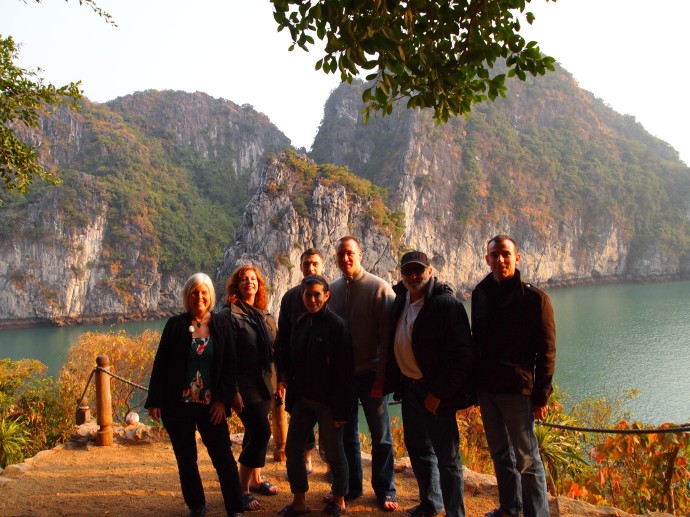
our fearless group of nomads from dragon pearl III
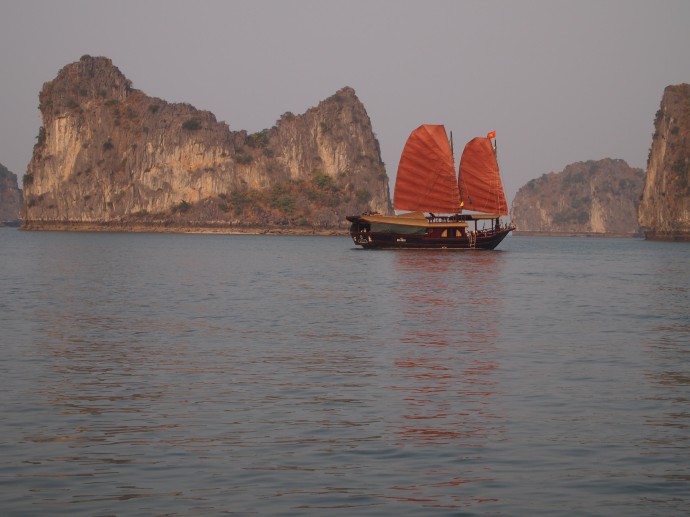
the view climbing up the island
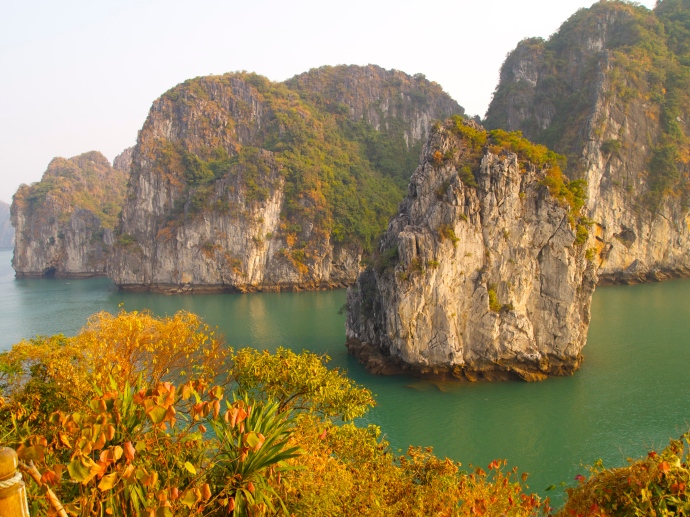
view from the side of the island
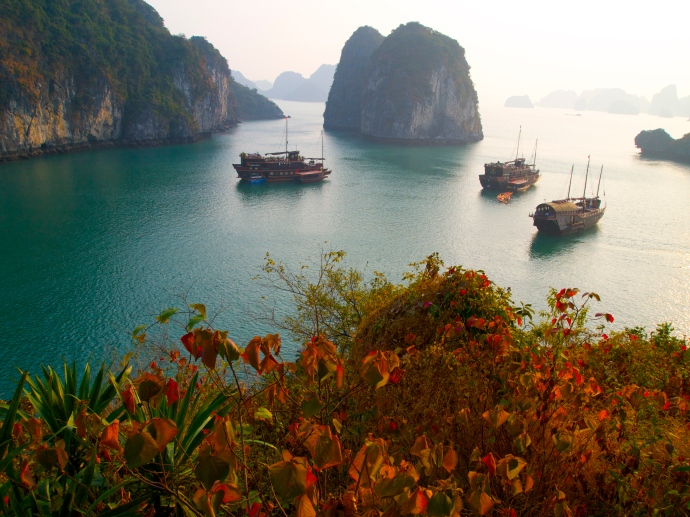
the view of our junk, and others, from the path to the cave
On the little island, we climb a path to reach caves filled with, alas, stalagmites and stalactites. Of course as in all things natural, rocks & clouds, we see familiar-shaped formations such as sea horses and dragons.
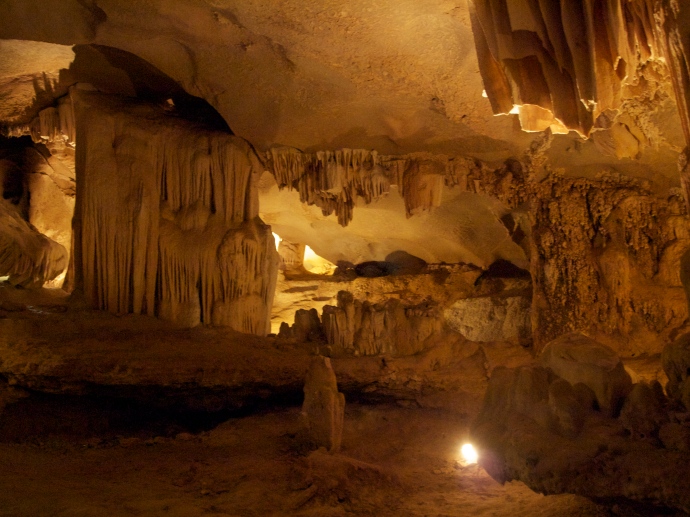
inside the cave
After exploring the cave, we clamber back down the path to the beach, where we don life vests and get into kayaks, promptly heading out into the rough and cold seas. Ruth and I are not experienced kayakers. We zigzag through the choppy water, waves jumping into our boat at every opportunity. Around the islands we go, paddling hard to keep up with the others, getting soaked and cold.
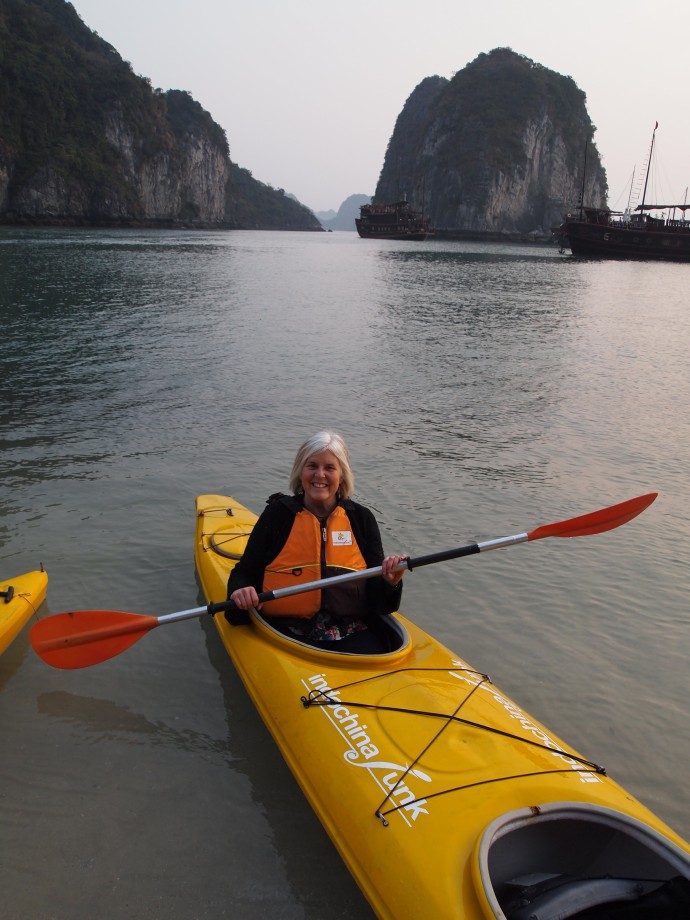
soaked and cold after our zigzag kayak trip
About halfway through the trip, Ruth and I see a path through the islands that looks like a shortcut back to our origination point; we ask if we can take it and then plow through. Funny thing is, when we get back using the shortcut, the others, who have gone the long way, come in for a landing right behind us. On the beach, we are welcomed by a rock formation shaped like a whale against the setting sun.
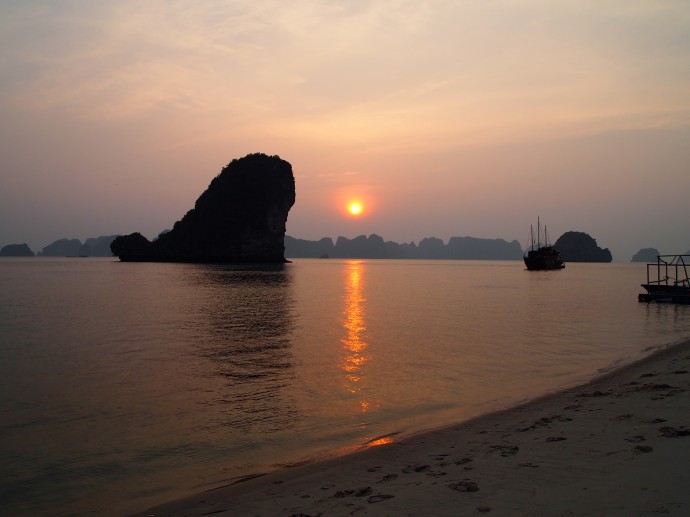
the whale on the island beach at sunset
Another extravaganza at dinner. Thanh again reads the menu aloud and tells us to get our cameras out as we will have much to see. Ruth and I prepare to enjoy by ordering a bottle of red wine. First, we’re served another fresh vegetable salad, covered delicately in some kind of spring-fresh sauce, cilantro abounding. Then out come the spring rolls, accompanied by two herons carved out of turnips. Prawns in a delicious sauce decorated by a dragon carved out of a pumpkin. Crayfish, very messy to peel, but delectable. Chicken, mackerel, rice, and more tropical fruits. And the grand finale carving: a sailing junk carved from a watermelon. Apparently, the chef spent three hours of his day carving these showpieces.
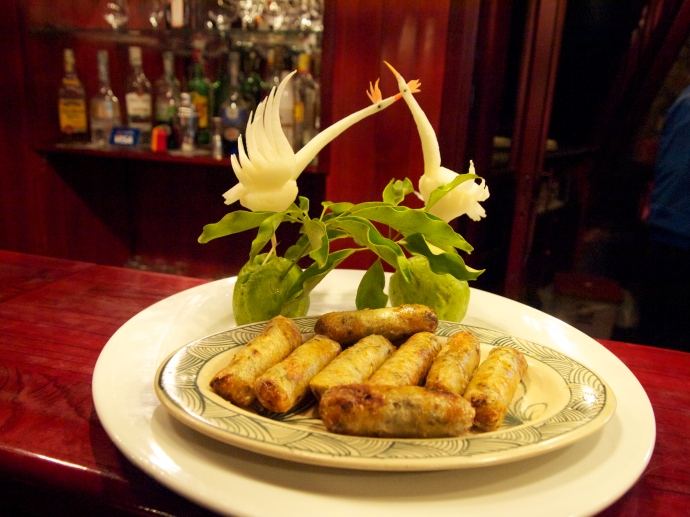
spring rolls with two herons carved out of turnips

a dragon carved from a pumpkin ~ with prawns 🙂
At dinner, we’re all drinking wine and enjoying lively conversation. Ryan marvels at Ruth’s eyes, tells her they are stunning. Ryan and Thea tell how they met on jury duty where neither of them were actually chosen, but in a random twist of fate, they found they lived five doors down from each other on the same street in Manhattan.
Ken tells us he went deaf from being a child of the 60s: too much loud music and too many drugs! We laugh about the drugs, questioning him as to what kind, and he replies: “There are not many I didn’t know…”

the chef with his sailing ship carved out of watermelon
We talk at great length about India, where Thea and Ryan went last year, and where I’m planning to go in March. They say they hated Delhi: “It’s so in your face!” But they adored Kerala, taking a house boat in Allepey: “it’s SO chill.”

the watermelon sailing ship 🙂
After dinner we go out to the deck, me wrapped in my black sweater and a royal blue towel ~ a fashion statement. Ruth and I sit with the French couple. Julia, short and squat and wrapped in a cream pashmina, has short blonde hair poking up in spots like a punk hairdo; she smokes and speaks French in a raspy voice. She doesn’t know much English, but Christo does so he translates. Ruth also speaks French quite capably and is able to carry on a halting conversation with both of them. Julia has that French classiness and elegance about her, despite her age and being out of shape; she’s really quite chic in an old world sort of way.

Julia & Christo ~ the French lovebirds
Earlier they had mentioned their kids were 42 and 45; I can believe her kids can be that old, but not his; he definitely looks younger, but then men often do. I say, I can’t believe you have 40-something kids! You look too young! Christo proceeds to tell us that there is a huge age difference between them; he is 51 and she is 70!! A 19 year age difference! They’ve been married for 33 years; he was 21 and she 40 when they got married, she a university professor and he her student, and they’ve been happy ever since. We can all tell they are still madly in love, the little French lovebirds. He is protective of her, like when we walked up the hills to the caves, he held her arm the whole time; he told Thanh that Julia didn’t care to go into the cave, so he wondered if we would exit through the entrance or through another exit.
When Christo tells me of their age difference and their long marriage, I say, Good for you! I’m so impressed that you have lived your lives outside the box, outside of what is socially acceptable. Bravo! I comment that they have a “joie de vivre” that’s quite obvious and infectious. I love the French lifestyle; as with most Europeans, they know how to truly enjoy life.
One of the two French boys (I know one is named Pasquale, but I don’t know which one, and the other’s name I don’t know!) is very quiet and the other is friendly and talkative and even a little flirtatious. I’m thinking he’s quite cute. But I’m unclear if the two are gay. I can’t tell as I don’t see any physical affection expressed between them. The one who’s quiet is such because he can’t speak much English, while the other (I’ll call him Pasquale) can speak English quite well. The two boys go fishing for squid off the bow of the boat, coming up every so often to show off their tiny slimy catches.
Meanwhile, I am disappointed in my own inability to speak or understand the French that is flitting about in the night air, especially considering the years I spent in half-ass study. It’s funny, I can understand Ruth’s Americanized version of French more than I can understand the French people’s speaking, in which all the words blend together in a string of unintelligible but lilting chatter.

happiness on halong bay
Later, back in my cabin, I write a while, as I left my book behind in my suitcase at the Ngocmai Hotel. I realize that today I feel quite intoxicated, high, not only from the bottle of wine I drank, but from life. From two days surrounded by interesting and adventurous people. From immersion in a fascinating culture. I haven’t felt happy in a long time, and now at this moment I can claim true happiness, in this time and space, as my own. I love meeting fellow nomads, soul-mate adventurers, sharing stories and our love of cultures. I love sharing new experiences with other vagabonds. We have a spirit connection, a thread of whimsy and a lust for life connecting us, dreamers all.
I’m floating, anchored, in the midst of whales and turtles and sea monsters in this bay of descending dragons. My cabin is toasty and pristine, and I’m under a white-cloud duvet, on a bed of pure white, rich paneled walls surrounding me. I try to draw the happiness I feel in my little notebook, but how does one draw happiness when one’s artistic ability is limited to stick figures, star doodles, hearts, musical notes, and smiley faces? How can I capture this happiness, bottle it, and take it with me back home, to Korea, where happiness is elusive as a firefly?


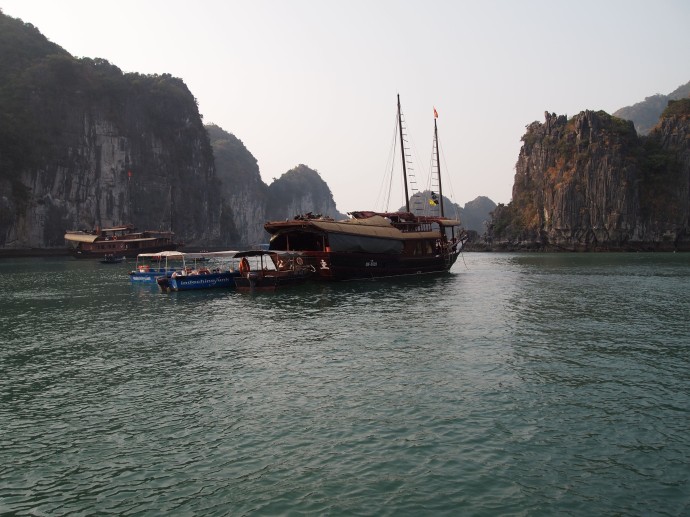



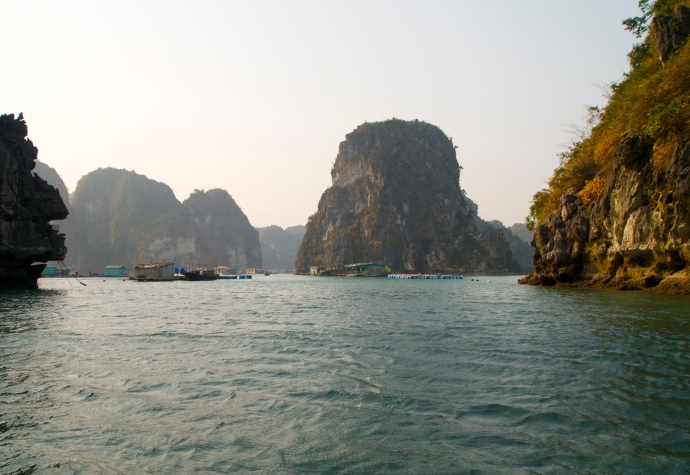
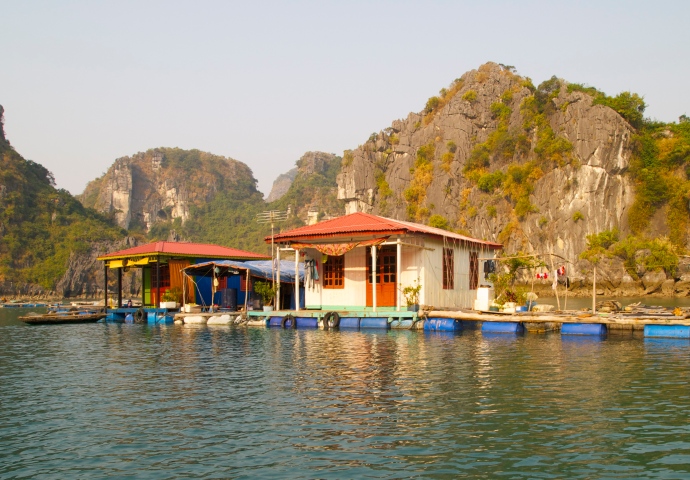
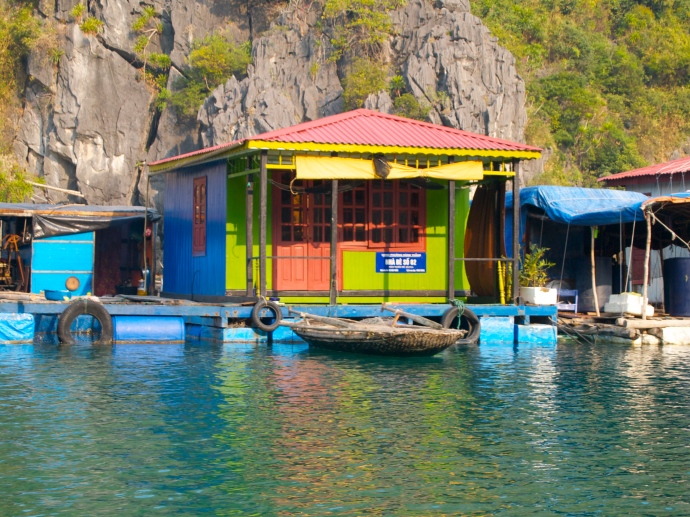



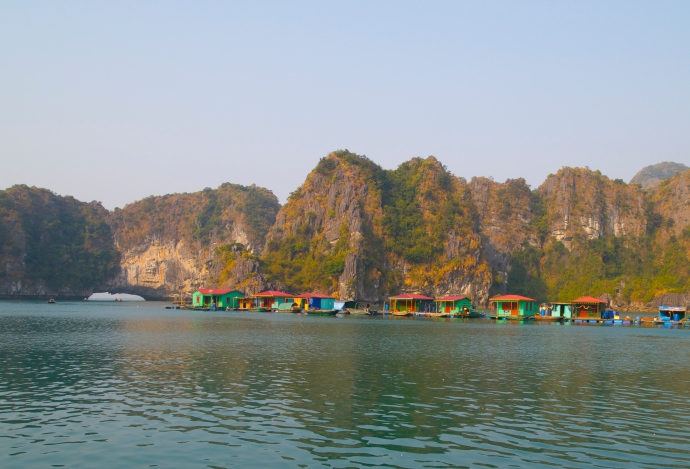
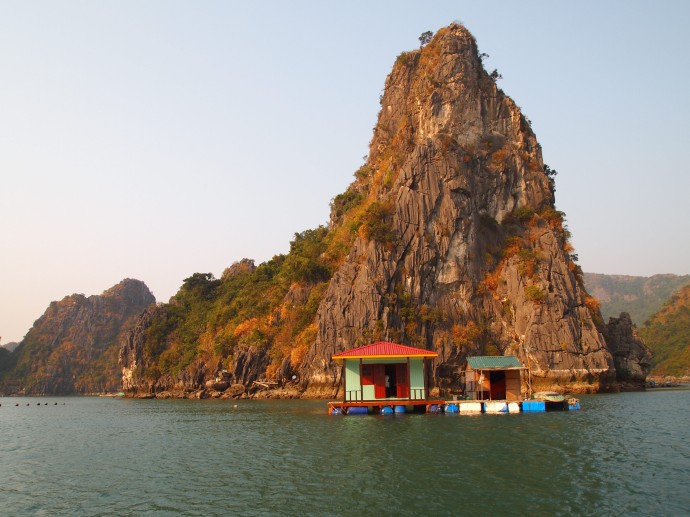
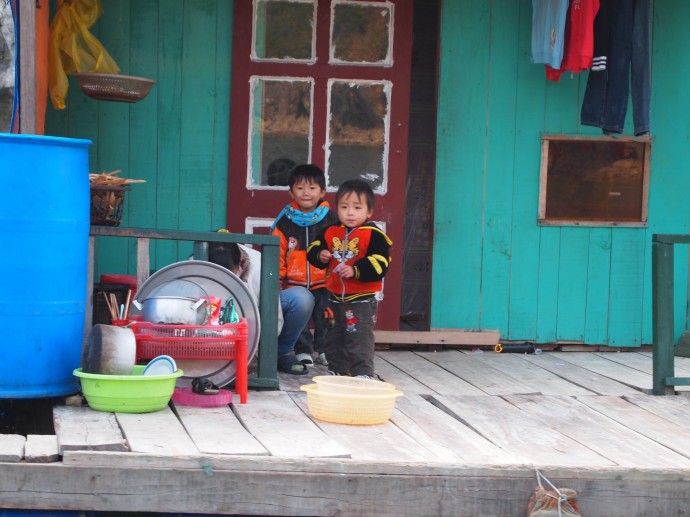
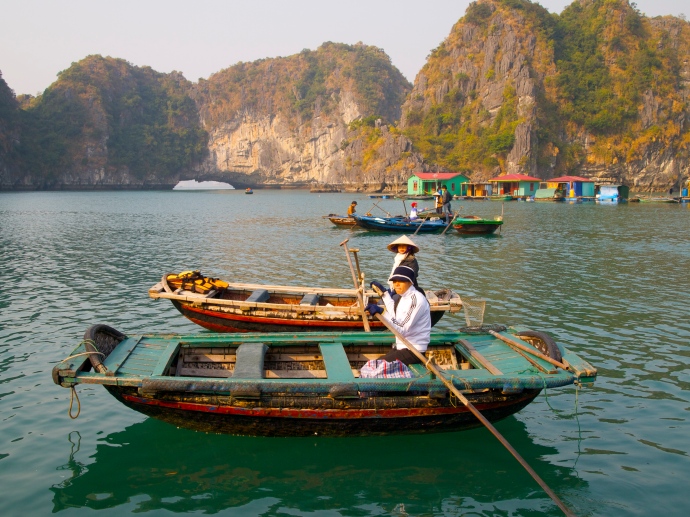
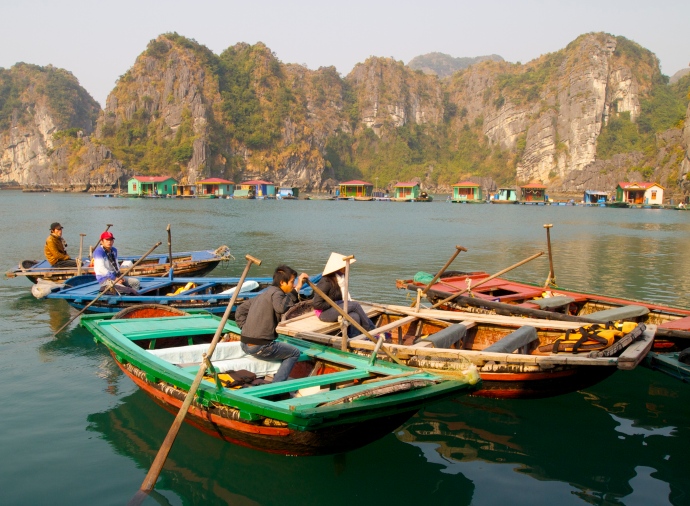
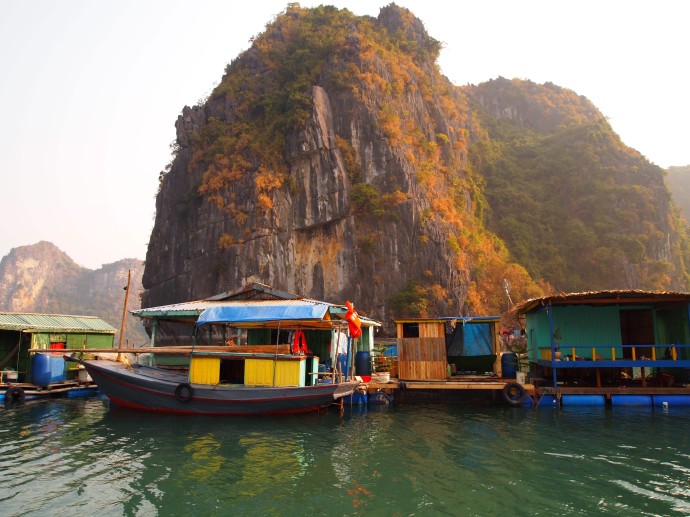
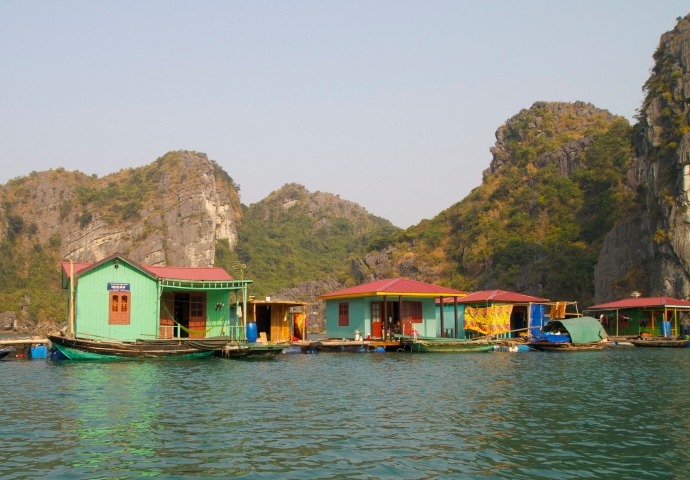


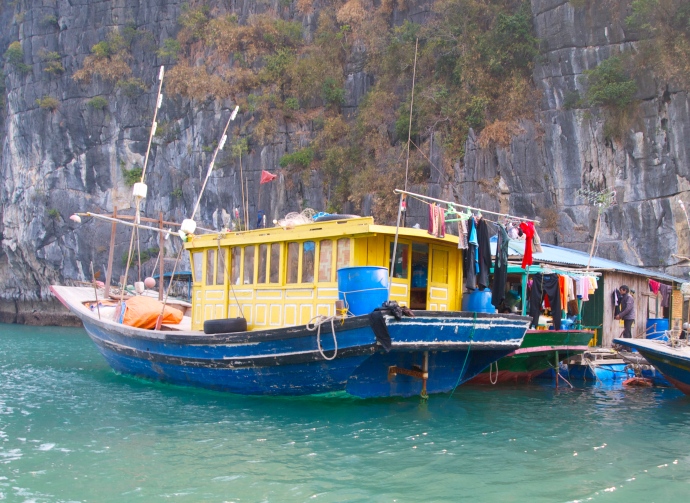
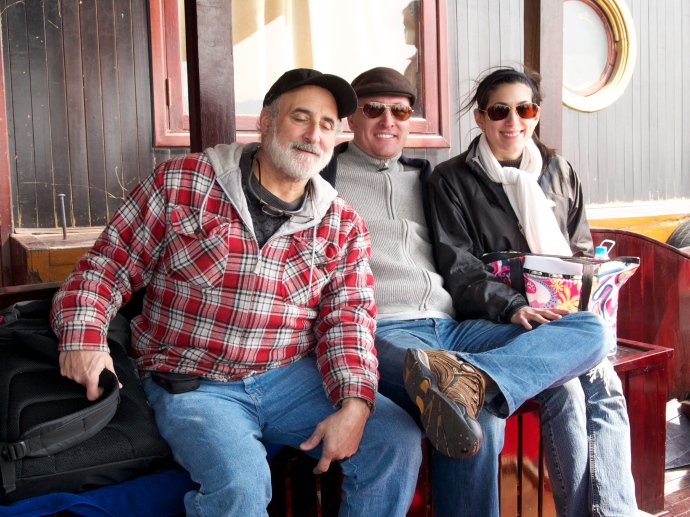

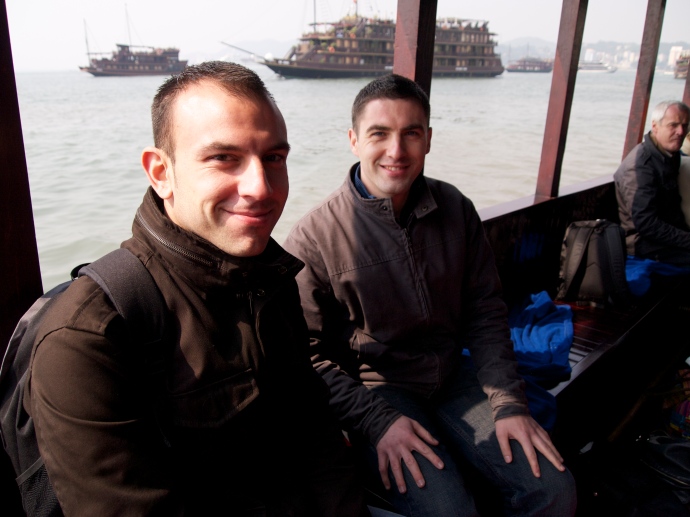
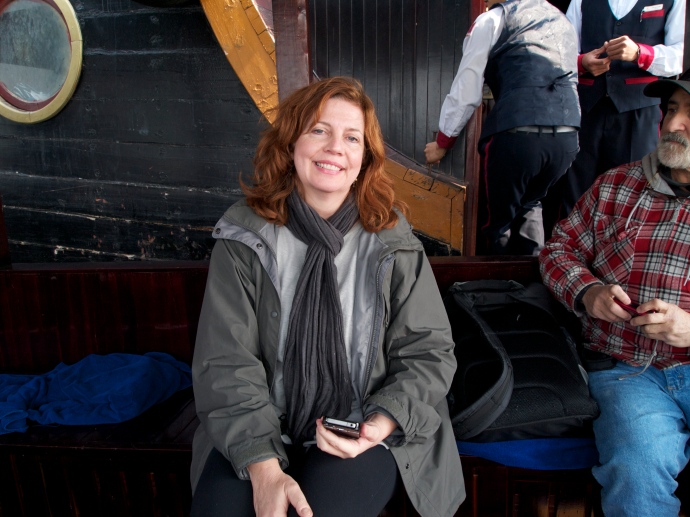

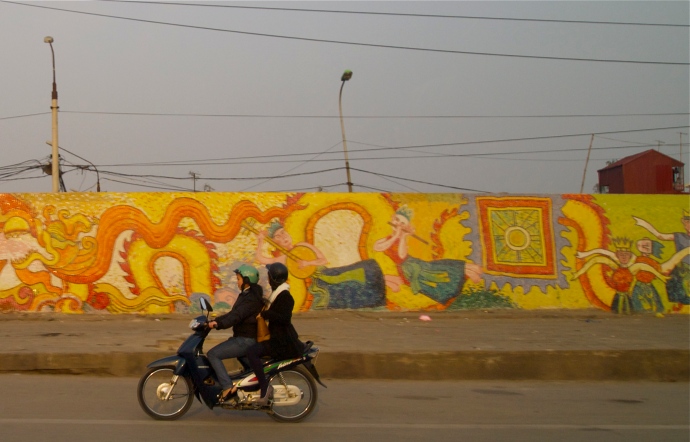

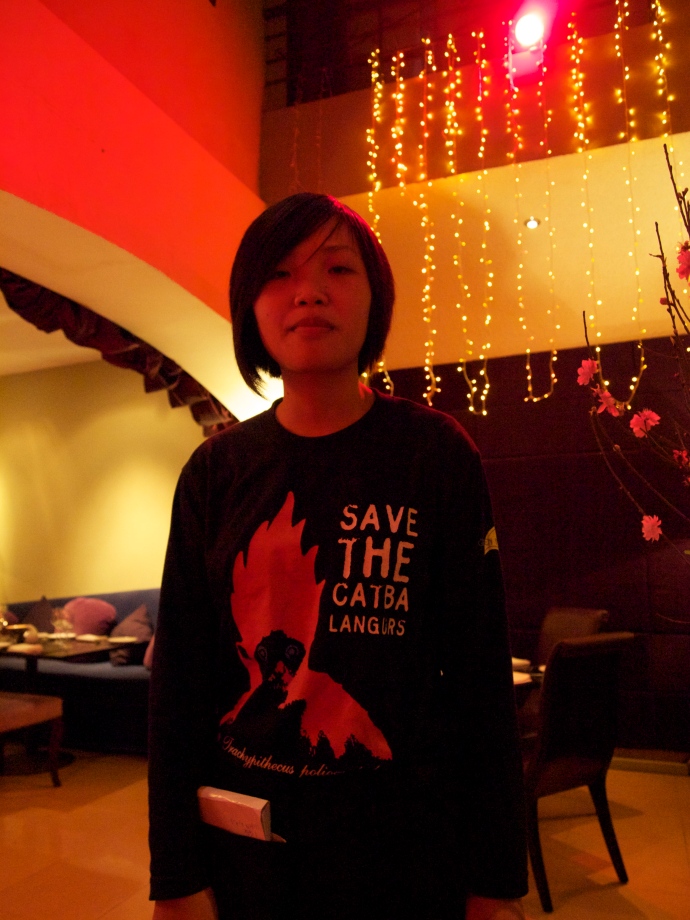
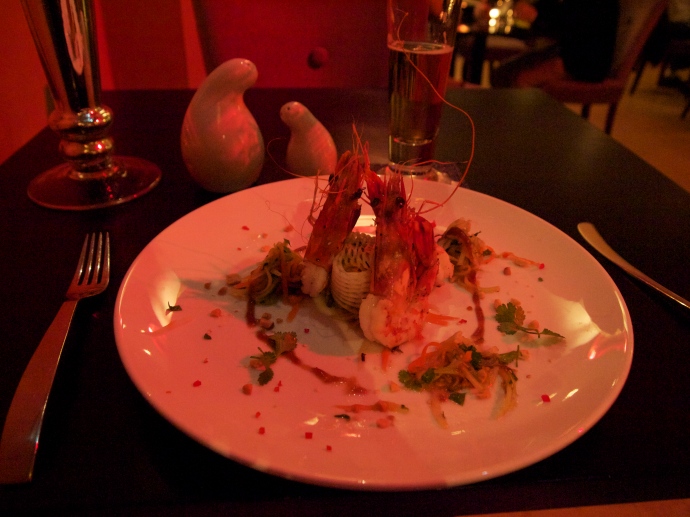
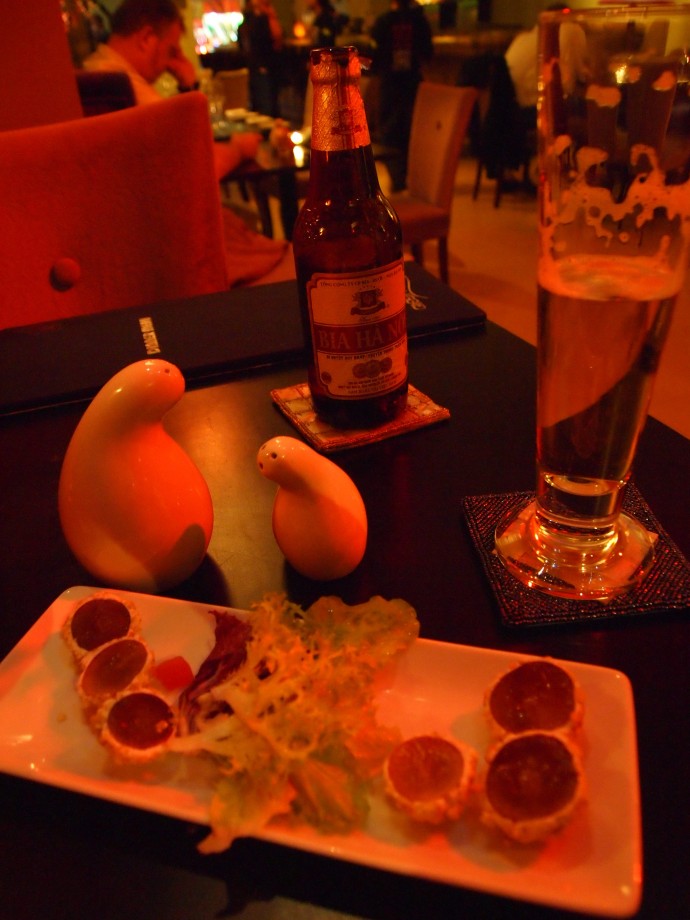































You must be logged in to post a comment.